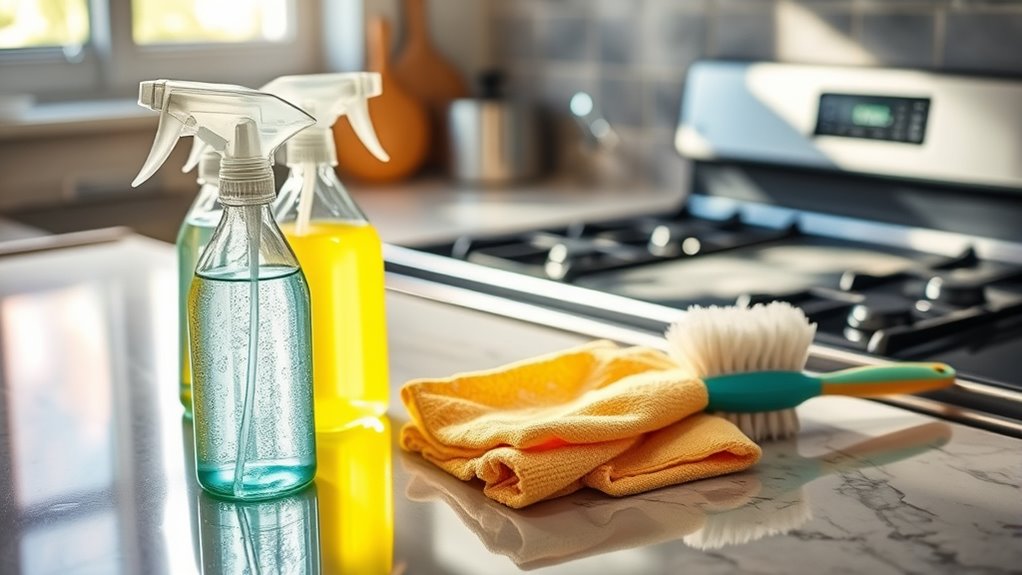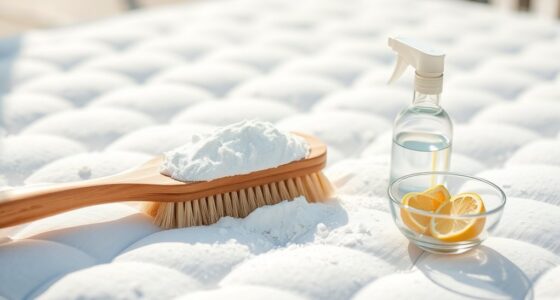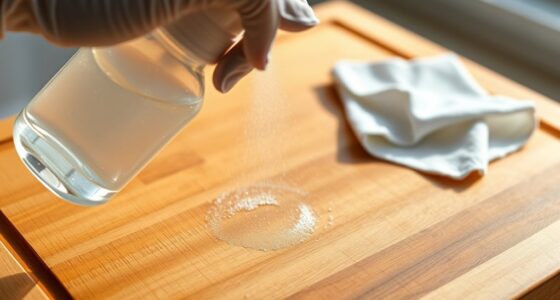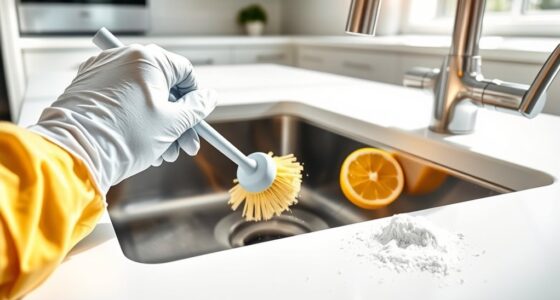To get rid of grease buildup in your kitchen, start by regularly cleaning surfaces using a mixture of warm water and dish soap. For tough stains, try a paste of baking soda and warm water. Don’t forget to cover nearby furniture while cleaning, and consider using cabinet liners to catch spills. Implement routine checks for grease in high-use areas and keep your cleaning supplies handy. There’s much more to learn about effective techniques and professional options to maintain a grease-free kitchen.
Key Takeaways
- Regularly clean high-traffic areas with a mix of warm water and dish soap to prevent grease buildup on surfaces and cabinets.
- Use a natural degreaser by mixing equal parts white vinegar and warm water for effective grease removal.
- Apply a baking soda paste to stubborn stains, allowing it to sit before scrubbing with a soft cloth.
- Install cabinet liners to absorb spills and simplify cleaning, helping to prevent grease from adhering to surfaces.
- Schedule professional cleaning services for deep cleaning tough grease buildup in appliances like ovens and hobs.
Understanding Grease Buildup in the Kitchen
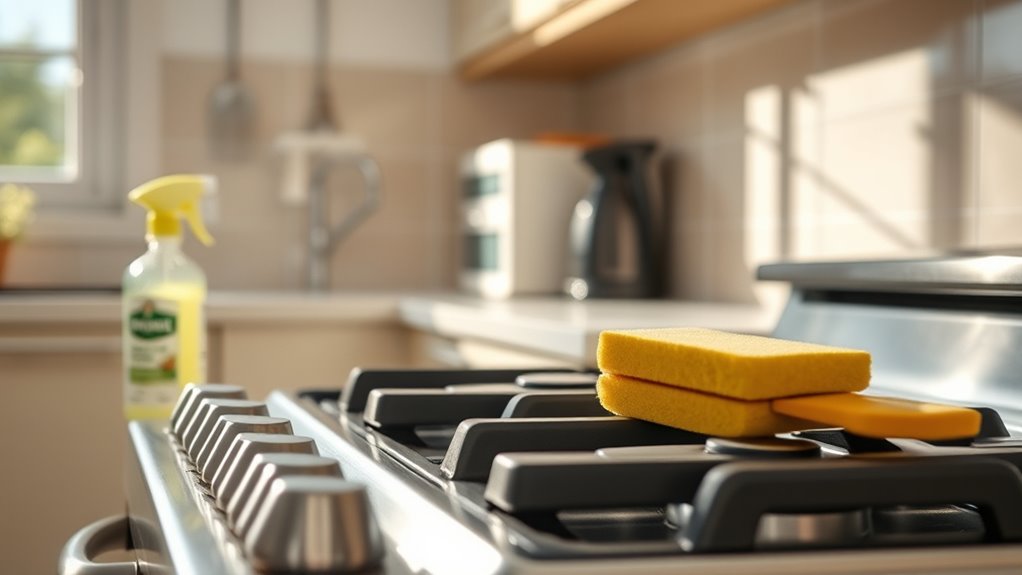
When you cook, grease naturally accumulates in your kitchen, often sticking to surfaces like cabinets and countertops. This grease buildup primarily occurs from splatters during frying, sautéing, and boiling.
If you don’t clean it promptly, sticky grease can tarnish your greasy kitchen cabinets, especially around the stove and sink. Regular maintenance is essential to prevent excessive buildup.
Neglecting grease buildup can damage your kitchen cabinets; consistent cleaning is key to maintaining their appearance.
To tackle tough stains, you can turn to natural cleaning products like white vinegar, baking soda, and lemon juice. For glossy kitchen cabinets, a mixture of warm water and mild dish soap works wonders, while wood cabinets benefit from a baking soda paste.
Implementing a regular cleaning routine and ensuring proper ventilation can help keep your kitchen cleaner and more hygienic.
Essential Cleaning Supplies for Grease Removal

To effectively tackle grease buildup in your kitchen, you’ll need a few essential cleaning supplies at your disposal. Start with concentrated liquid dish soap, ideal for breaking down grease when mixed with warm water. A sponge scrubber will help you gently remove grease without damaging surfaces, while bar towels are great for drying and wiping down. Don’t forget rubber gloves to protect your hands from harsh cleaning agents. Paper towels can quickly absorb excess grease, especially on dirty surfaces, and a long-handled scrub brush will reach those tough spots.
| Supply | Purpose | Usage |
|---|---|---|
| Dish Soap | Breaks down grease | Mix with warm water |
| Sponge Scrubber | Gentle scrubbing | Use on surfaces |
| Rubber Gloves | Protects hands | Wear during cleaning |
Preparing the Kitchen for a Deep Clean
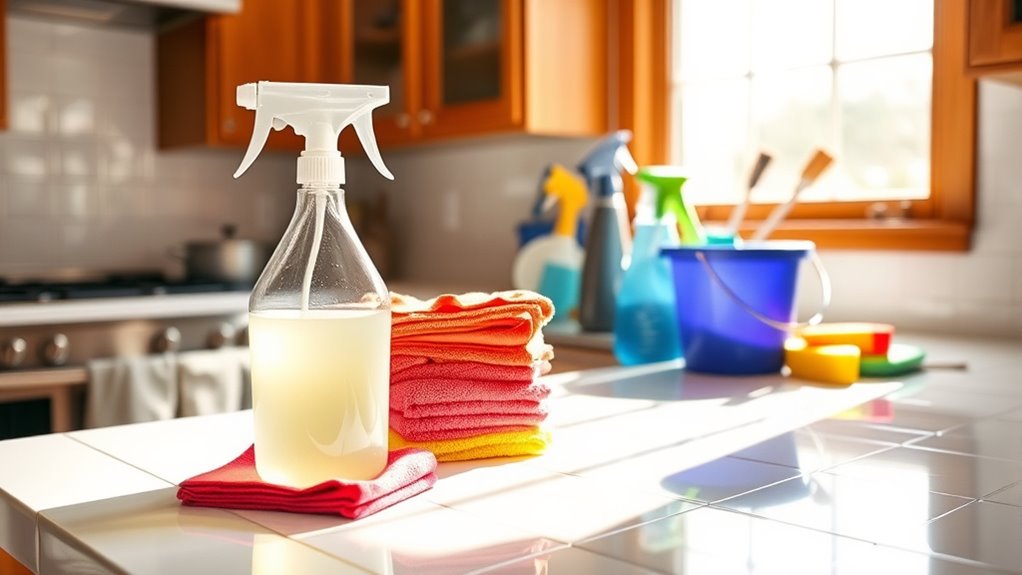
After gathering your cleaning supplies, it’s time to prepare your kitchen for a deep clean.
Start by removing all items from your countertops, cabinets, and shelves. This guarantees you can thoroughly clean every surface and prevents any grease splatter from dirtying your belongings.
Next, consider covering nearby appliances and furniture with drop cloths or old sheets to protect them during the process.
Cover nearby appliances and furniture with drop cloths or old sheets to shield them from potential messes during your deep clean.
Here are some steps to help you get started:
- Blot any immediate grease spills with paper towels or a damp cloth.
- Use a cleaning solution mixed with warm water for better results.
- Guarantee proper ventilation by opening windows or turning on exhaust fans.
- Create a comfortable cleaning environment for yourself.
With these preparations, you’re ready to remove the grease effectively!
Effective Cleaning Methods for Greasy Surfaces
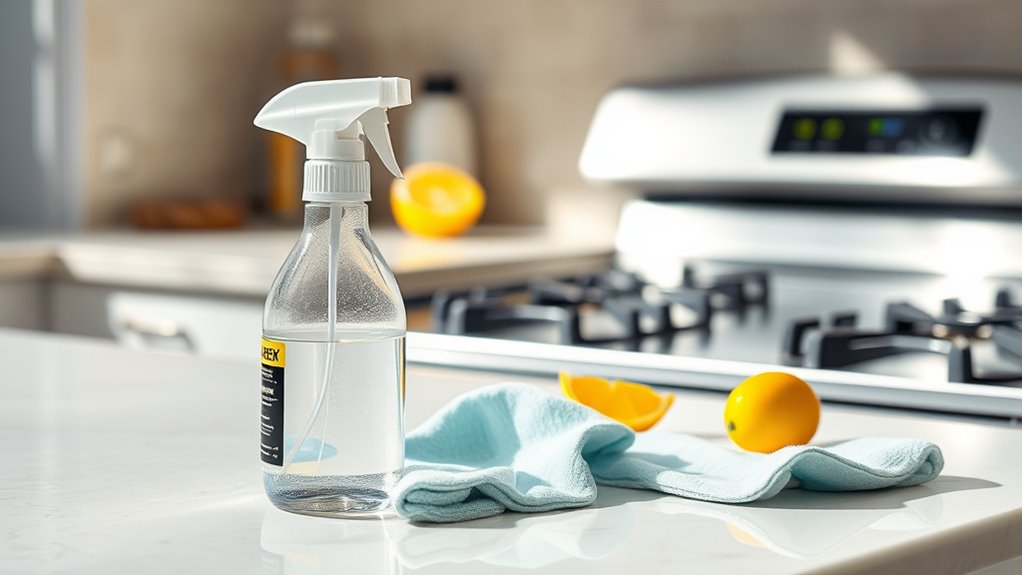
As you tackle greasy surfaces in your kitchen, choosing the right cleaning method can make all the difference.
For kitchen cabinets, mixing Dawn dish soap with warm water is highly effective, rated 4.5 out of 5 for cutting through grease and grime quickly.
If you need a quicker option, Pledge Everyday Cleaner works well, requiring just two minutes of application time and earning a 4 out of 5 rating.
For a different approach, try mixing Murphy Oil Soap with warm water, although its 3 out of 5 rating reflects a less effective solution, plus it has a lingering citronella scent.
Regular cleaning with these methods helps prevent excessive grease buildup, keeping your kitchen hygienic and maintaining your cabinets’ longevity.
Tackling Stubborn Grease Stains
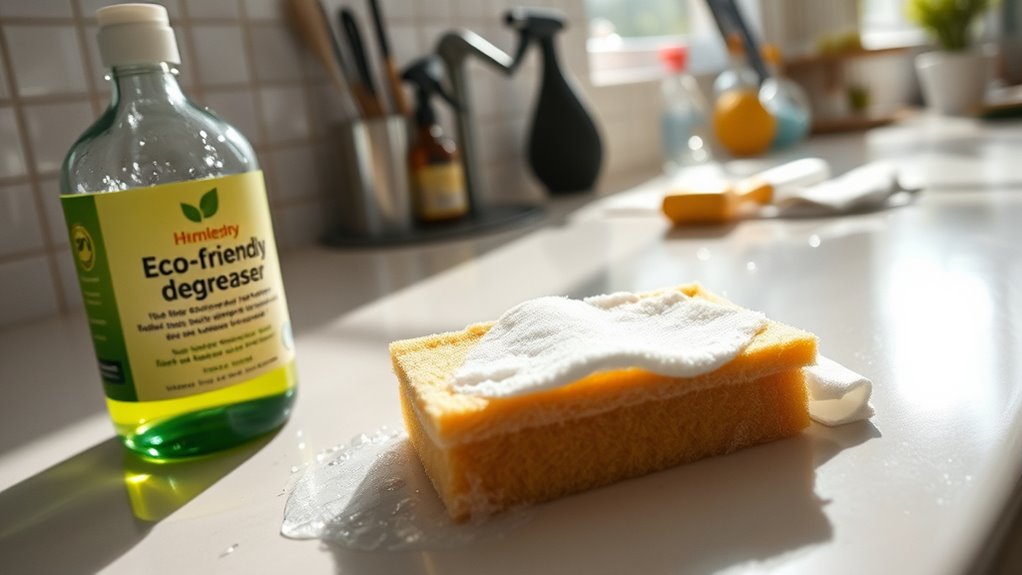
When those stubborn grease stains refuse to budge, you’ll need effective cleaning solutions to tackle them head-on.
Consider mixing baking soda with warm water or using a vinegar spray for a powerful punch against grease.
Plus, keeping up with preventive maintenance will help you avoid those tough spots in the future.
Effective Cleaning Solutions
Tackling stubborn grease stains in your kitchen doesn’t have to be a chore. With the right cleaning solutions, you’ll have those greasy spots gone in no time.
Here are some effective methods to contemplate:
- Baking Soda Paste: Mix 1 cup of warm water with 1 cup of baking soda, apply it to the stains, and let it dry before wiping it off.
- Vinegar Spray: Combine equal parts vinegar and warm water, spray it on the stains, let it sit for 5 minutes, then wipe clean.
- Soap Solution: Use dish soap mixed with warm water, applying it with a sponge in circular motions for general grease removal.
- Flour or Cornstarch: Sprinkle over fresh grease spills to absorb it, then wipe away after a few minutes.
These solutions can keep your kitchen looking great!
Preventive Maintenance Tips
To keep stubborn grease stains at bay, you need to adopt a few simple preventive maintenance habits in your kitchen.
Regularly clean surfaces with a solution of warm water and dish soap directly to break down grease molecules before they become difficult to remove. For tougher stains, mix equal parts baking soda and water to form a paste; apply it, let it dry, and then wipe it away with a damp cloth.
Use a 50/50 mixture of white vinegar and warm water to spray greasy areas, allowing it to sit for a few minutes to help dissolve the grease.
Don’t forget to improve kitchen ventilation with a cooker hood, and use cabinet liners to catch splatters for easier clean-up.
Regular Maintenance Tips to Prevent Grease Accumulation
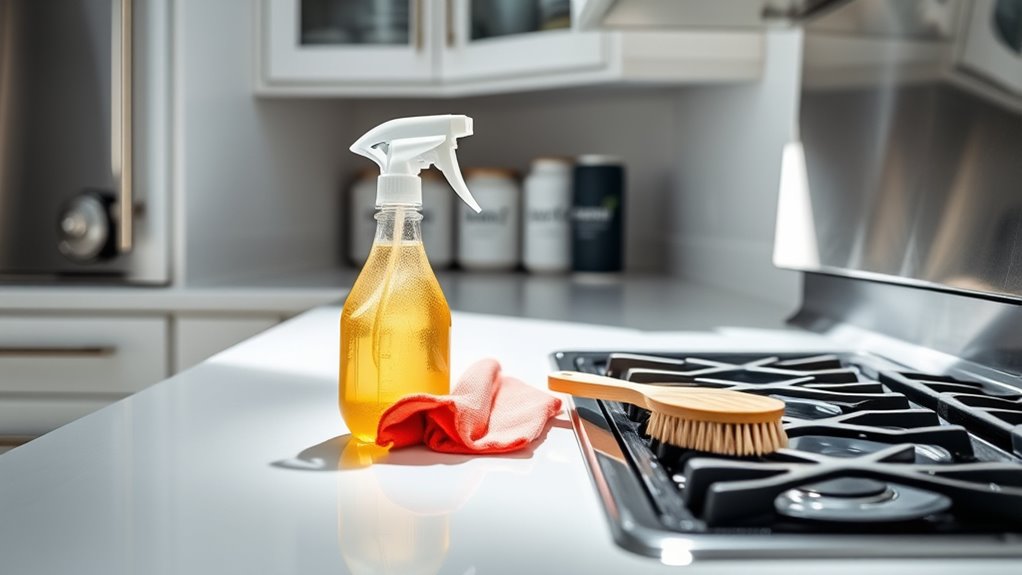
To keep grease accumulation at bay, establish a daily cleaning routine that includes wiping down surfaces after cooking.
Make sure you’re using proper ventilation practices, like running your extractor fan, to prevent airborne grease from settling.
Additionally, consider using protective covers to shield your cabinets and countertops from splatters and spills.
Daily Cleaning Routine
Since a clean kitchen is essential for both hygiene and cooking efficiency, establishing a daily cleaning routine can greatly reduce grease buildup.
By dedicating just a few minutes each day, you can effectively manage light grease and maintain a spotless kitchen.
- Wipe down surfaces like countertops and cabinets with warm, soapy water.
- Use a damp microfiber cloth to quickly wipe away splatters after cooking.
- Keep a spray bottle filled with a 50/50 mix of white vinegar and warm water for instant spot cleaning.
- Clean stovetops and backsplashes immediately after use to prevent grease from hardening.
- Incorporate regular maintenance to ensure your kitchen remains in top condition.
Proper Ventilation Practices
While you might enjoy cooking up a storm, neglecting proper ventilation can lead to frustrating grease buildup in your kitchen. To combat this, invest in a high-quality range hood or extractor fan that vents to the outside. This setup effectively removes smoke, steam, and odors, preventing grease particles from settling back in.
Don’t forget to clean or replace the range hood filters every 1-3 months to maintain ideal air quality. Additionally, using lids on pots and pans while cooking can minimize grease splatter.
Establish a routine for regular cleaning, too—wiping down surfaces and appliances after cooking keeps grease from hardening and makes it easier to manage. Proper ventilation and frequent maintenance are key to a grease-free kitchen.
Use of Protective Covers
Protecting your kitchen surfaces from grease accumulation can save you time and effort during cleaning.
Using protective covers, like cabinet liners and pot lids, keeps grease stains at bay and simplifies your cleaning routine. Here are some effective tips to help you maintain a grease-free kitchen:
- Install cabinet liners to absorb spills and make cleaning easier.
- Use lids on pots and pans to minimize grease escape while cooking.
- Clean kitchen surfaces regularly with a gentle soap solution to prevent grease from hardening.
- Establish a weekly or bi-weekly cleaning routine for high-traffic areas to keep grease buildup under control.
Natural Alternatives for Grease Cleaning

If you’re looking to tackle grease buildup in your kitchen, natural alternatives can be your best friends. A simple mix of white vinegar and warm water in a 50/50 ratio serves as a potent degreaser for kitchen cabinets, cutting through stubborn grease effortlessly.
You can also combine lemon juice with baking soda to create a powerful paste that tackles those tough stains. For fresh grease spills, sprinkle cornstarch to absorb the mess quickly.
Don’t forget to add essential oils like tea tree or eucalyptus; they enhance your natural cleaning agents while leaving your kitchen smelling fresh. Regularly using these alternatives promotes a healthier environment and reduces your reliance on harsh chemicals.
Cleaning Techniques for Different Cabinet Types
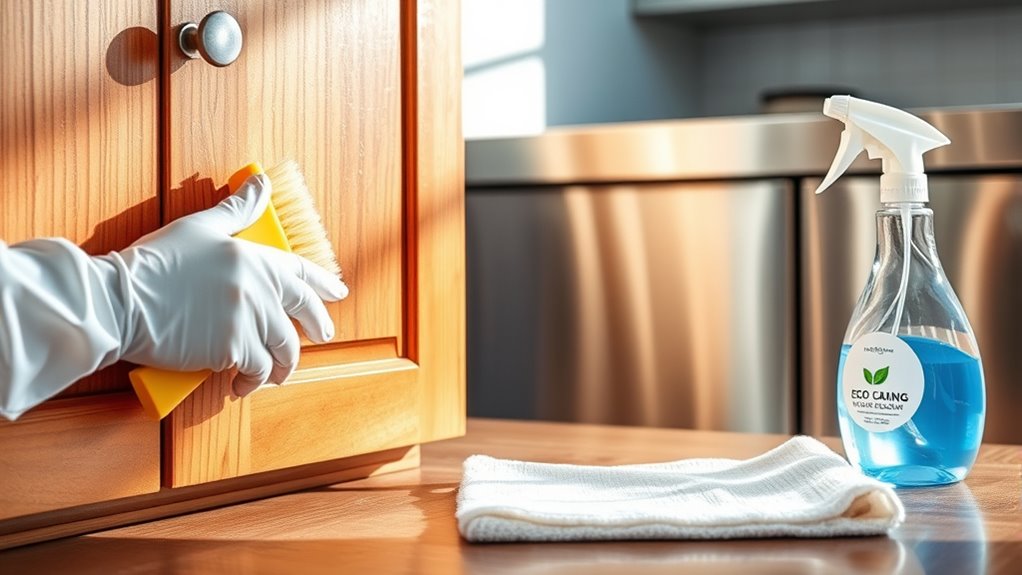
Natural cleaning alternatives can effectively tackle grease, but knowing how to clean different cabinet types is just as important for maintaining a spotless kitchen.
- For gloss cabinets, mix warm water with mild dishwashing soap and scrub gently with a soft cloth. Use white vinegar or baking soda for tougher stains.
- Clean greasy wood cabinets with warm water and dish soap, applying a baking soda paste for heavy grease.
- A 50/50 mix of white vinegar and warm water can degrease cabinets—spray, let sit, then wipe.
- After cleaning wood cabinets, consider beeswax products to prevent drying and maintain shine.
Professional Cleaning Options for Tough Grease Buildup
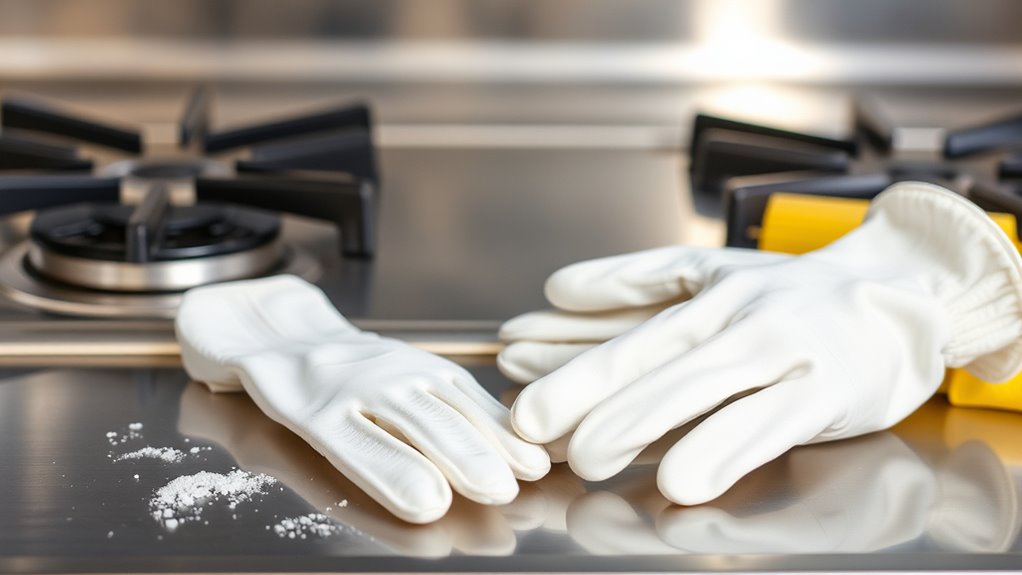
When grease buildup becomes too much for DIY methods, turning to professional cleaning services can be a game-changer.
Companies like Ovenclean specialize in deep cleaning kitchen appliances, including ovens and hobs, effectively tackling stubborn grease stains that often resist standard cleaning techniques. They use advanced methods and eco-friendly products to restore your kitchen to pristine condition without harmful chemicals.
The booking process is simple; just schedule an appointment online and receive a free quote tailored to your cleaning needs.
Professional cleaners can complete the job in a fraction of the time, ensuring a thorough clean without the hassle of extensive DIY efforts. Regular cleanings not only maintain kitchen hygiene but also make future tasks easier and less time-consuming.
Frequently Asked Questions
How Do You Get Rid of Heavy Grease in the Kitchen?
To tackle heavy grease, start by mixing warm water with dish soap.
Apply it to the greasy areas and let it sit for a few minutes before scrubbing.
You can also create a paste with baking soda and warm water for stubborn spots.
For quick spills, sprinkle flour or cornstarch to absorb the grease.
Don’t forget to use a solution of vinegar and water regularly to keep surfaces clean and grease-free.
Is Vinegar or Baking Soda Better for Grease?
Choosing between vinegar and baking soda for grease is like selecting the right tool for a job; each has its strengths.
If you’re tackling fresh stains, vinegar’s acidity works wonders. However, for stubborn, dried grease, baking soda’s abrasive paste is your best bet.
You might even combine them for a powerful duo—vinegar breaks down the grease while baking soda scrubs it away.
Ultimately, it depends on the type of grease you’re facing.
What Will Dissolve Hardened Grease?
To dissolve hardened grease, you can use a few effective methods.
Start with a warm water and dish soap mixture, which breaks down grease with its surfactants. For tougher stains, create a paste with baking soda and warm water, or use heated white vinegar for its acidity.
A 50/50 mix of vinegar and warm water can also work wonders. If you prefer, try commercial degreasers containing citrus oils for a natural solution.
How Do You Remove Icky Sticky Greasy Gunk From Kitchen Cabinets?
To remove that icky sticky greasy gunk from your kitchen cabinets, mix warm water with a few drops of dish soap.
Apply it with a cloth, wiping away the grime. For tougher stains, create a baking soda paste, let it dry, then wipe it off.
Alternatively, spray a 50/50 mix of white vinegar and warm water, letting it sit for a couple of minutes before wiping clean.
Always spot test before applying!
Conclusion
As you tackle the grease buildup in your kitchen, think of each wipe and scrub as a step toward reclaiming your culinary sanctuary. Just like a phoenix rising from the ashes, your kitchen can transform into a gleaming space where creativity flourishes. By keeping up with regular maintenance and using effective cleaning methods, you’ll guarantee that grease won’t overshadow your cooking adventures. Embrace the journey of cleanliness, and let your kitchen shine brightly once more!

